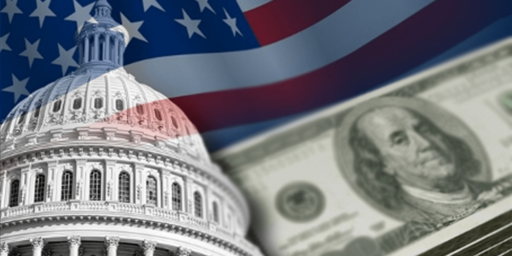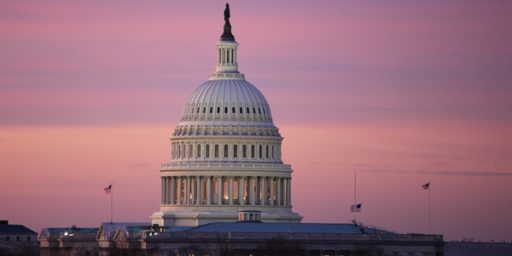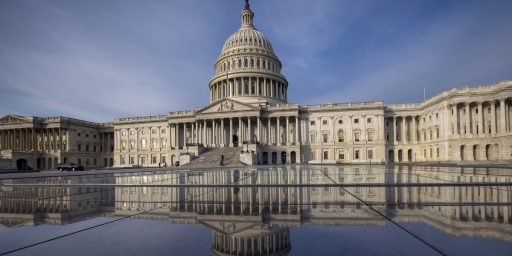’10 Percent Increase’ Hardly a ‘Massive Infusion of Spending’
WaPo is overhyping things a bit.
WaPo is overhyping things a bit with the headline “Massive infusion of spending ends era of restraint for federal agencies, Pentagon.”
The massive infusion of cash approved by Congress early Friday morning is slated to lift the budgets of federal agencies and the Pentagon far beyond what they were at the start of the Trump presidency, ending the era of spending restraint that gripped Washington for most of this decade.
The deal signed into law by President Trump will pump more than $500 billion in additional money into domestic agencies and the Pentagon over two years, the biggest increase in spending in almost a decade. It ends months of budget squabbles and provides greater certainty for the government officials responsible for the military, disaster relief and domestic agencies.
At the same time, congressional aides and lobbyists say the deal will prompt a burst of activity as lawmakers, agencies and lobbyists attempt to influence where the money will go.
While Congress approved a 10 percent increase in spending for the Pentagon and domestic agencies — lifting the military budget to $700 billion this year and the domestic budget to $591 billion — appropriators on 12 different committees have to fill in many of the details. New partisan clashes are expected over sensitive issues such as where the Pentagon will spend its money and whether the Department of Homeland Security might try to apportion funding to a border wall.
“Beltway bandits, lobbyists and military contractors everywhere are probably popping the champagne corks,” said Jim Manley, who served as an aide to former Senate majority leader Harry M. Reid (D-Nev.).
While half a trillion over two years is indeed a lot of money from the standpoint of the congressional districts and contractors vying for their share, it’s simply not that much money in the scheme of the federal budget. Indeed, it’s hard to square “10 percent increase” with “massive infusion of cash.”
Further, while the ten percent boost will doubtless be welcome, we have to remember that it comes after a decade of not only “austerity” but also of continuing resolutions. That means agencies will mostly use the money to recover from shortfalls and increased costs associated with not being able to properly budget and procure over a long period. Not to mention the millions wasted every time the government either shut down (three times) or had to prepare for a shutdown that never came but wasn’t averted until the 11th hour (at least a dozen times).
At DoD, this is further complicated by the fact that the military has been deployed to war for seventeen years with no end in sight. That means lots of equipment that has been worn out and needs to be replaced. In some cases, to be sure, it will be with improved versions. Mostly, though, it’ll be catch-up rather than a boost in capability.
So, yay to Congress for finally doing its Constitutionally-mandated job of passing a budget. And yay for at least two years of relative fiscal stability to come. But this isn’t exactly a shower of money that’s going to result in agencies being able to spend like drunken sailors.







I’m not sure where you are getting that figure. Discretionary and defense spending is increasing by $300 billion over two years, not 1/2 a billion.
It’s massive and wildly irresponsible. Meanwhile, we spent $337 million per day from 2001-14 on the GWOT.
It should be noted that this bill simply lifts previously imposed spending caps and adjusts the debt ceiling to accommodate. It does not actually appropriate anything as far as I can tell on first review. It leaves that to the appropriations committees.
I was going to argue that even though it’s only 10%, that rate is three times the rate of inflation, but both your argument and HL’s accounting of the process reveal the event as reasonable. On the other hand, it does argue for the overarching difficulty of balancing the budget at all, let alone by cutting out WFA, and against the wisdom of tax cuts to gin up the system.
The real problem related to the public’s understanding of the budget may be that the numbers are beyond our ability to comprehend. In Korea, because the major counting units are 1, 10, 100, 1000, 10,000, 1,000,000, it was common in talking with Koreans about costs that they would make orders of magnitude mistakes in comprehension when speaking English. Similar situation here. Spending even 10 billion on something sounds like a lot of money, in a multi-trillion dollar budget, it’s a rounding error.
@Just ‘nutha ig’nint cracker: It would be emminently reasonable, if they were paying for it. But on top of a large tax cut, it’s just stupid.
@gVOR08: Won’t disagree with you there. Merely noting that I get the math that Joyner and HL are using to explain the rationale(???) such as it is.
@Andy: Typo. It’s half a trillion.
@Just ‘nutha ig’nint cracker: @gVOR08: Right. It’s simultaneously fiscally irresponsible—especially in concert with the tax cuts—and not going to be perceived as a lavish increase at the operating end of things.
@Just ‘nutha ig’nint cracker:
In colloquial terms, this is the equivalent of the bank raising your credit limit. You haven’t spent the extra funds (yet), but we can be certain that you will.
The massive infusion of actual spending will come in the appropriations bills. What those actually spend money on (and, more to the point, what they don’t) will be the tell.
More important is the deficit and the effect it could have on the dollar and the credit situation. In 2008 things were different. We had some back up and emergency doors. Next time we have nothing. Imagine waking up and the banks closed, amt machines off, debit cards worthless, gas stations closed, a currency shortage, and food in short supply. It could happen.
James, I realize you analysis is more detailed than this, but I want to make a more general point about why a true 10% raise for something like the military IS a huge increase. At a guess, I would imagine that the military has something like 70-80% fixed costs. These include salaries, costs of maintaining bases and equipment, standard replacement due to wear and tear, etc. I would further suspect that most of the discretionary spending is tied up in things that are so long term as to be effectively a fixed cost, such as developing new planes, ships and fighting vehicles. So decision makers are left with true discretionary spending in the low single digits. 10% would be a huge increase on that.
Once again, I must object to your association of federal bureaucrats with drunken sailors. Drunken sailors sober up.
@Boyd: Touche.